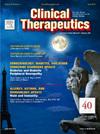Tranexamic Acid for Preventing Secondary Post-Tonsillectomy Bleeding: Insights From A Retrospective Cohort Study
IF 3.6
4区 医学
Q2 PHARMACOLOGY & PHARMACY
引用次数: 0
Abstract
Purpose
Post-tonsillectomy bleeding (PTB) is the leading cause of re-operation and mortality following tonsillectomy. Tranexamic acid (TXA) has been widely utilized in various medical fields to manage bleeding. However, its efficacy in preventing bleeding after tonsillectomy remains uncertain. This study aimed to assess the effectiveness of systemic (intravenous or oral) TXA in reducing the incidence of secondary PTB post-tonsillectomy.
Methods
A retrospective cohort study at the Ambulatory Care Center in Qatar evaluated patients undergoing tonsillectomy from January 2021 to January 2024. Chi-square and multilogistic regression analyses were used to examine the relationship between TXA use and secondary PTB incidence.
Findings
A total of 2314 patients were evaluated, primarily pediatrics (89.1%), Arabic (89.3%), and male (57.5%). TXA was prescribed post-tonsillectomy for 233 patients (10.1%), with intraoperative use in 44 patients (1.9%). No significant difference in incidence of secondary PTB was observed between control group and TXA use post-tonsillectomy (5.0% vs 3.9%, P = 0.52). Among 114 secondary PTB cases, the mean hemoglobin drop was 1.7 (2.1) in the non-TXA group and 0.93 (1.2) in the TXA group (P = 0.23). Surgical intervention was needed in 24% of non-TXA patients (P = 0.11). Rates of blood transfusion, ICU admission, and significant hemoglobin drop were similar. TXA post-tonsillectomy did not significantly reduce PTB odds (OR 0.18, P = 0.13), but composite data of either intraoperative or discharge TXA administration significantly reduced PTB odds (OR 0.03, P = 0.004).
Implications
Post-tonsillectomy use of TXA did not significantly reduce secondary PTB but showed a nonsignificant trend towards less surgical reintervention. Composite of either intraoperative or discharge TXA significantly lowered PTB odds, suggesting potential benefits that warrant confirmation through larger studies.
氨甲环酸预防扁桃体切除术后继发性出血:来自回顾性队列研究的见解。
目的:扁桃体切除术后出血(PTB)是扁桃体切除术后再手术和死亡的主要原因。氨甲环酸(TXA)已广泛应用于各种医学领域的出血治疗。然而,其预防扁桃体切除术后出血的功效仍不确定。本研究旨在评估全身(静脉或口服)TXA在降低扁桃体切除术后继发性PTB发生率方面的有效性。方法:卡塔尔门诊护理中心的一项回顾性队列研究评估了2021年1月至2024年1月接受扁桃体切除术的患者。采用卡方分析和多元logistic回归分析来检验TXA使用与继发性肺结核发病率之间的关系。结果:共评估了2314例患者,主要是儿科(89.1%)、阿拉伯(89.3%)和男性(57.5%)。233例患者(10.1%)在扁桃体切除术后使用TXA, 44例患者(1.9%)在术中使用TXA。对照组与使用TXA的扁桃体切除术后继发PTB的发病率无显著差异(5.0% vs 3.9%, P = 0.52)。114例继发性肺结核患者中,非TXA组平均血红蛋白下降1.7 (2.1),TXA组平均血红蛋白下降0.93 (1.2)(P = 0.23)。24%的非txa患者需要手术干预(P = 0.11)。输血率、ICU入院率和显著血红蛋白下降率相似。扁桃体切除术后服用TXA并未显著降低PTB的几率(OR 0.18, P = 0.13),但术中或出院时服用TXA的综合数据均显著降低了PTB的几率(OR 0.03, P = 0.004)。意义:扁桃体切除术后使用TXA并没有显著减少继发性PTB,但没有显示出减少手术再干预的显著趋势。术中或排出TXA的组合显著降低了PTB的几率,表明潜在的益处值得通过更大规模的研究来证实。
本文章由计算机程序翻译,如有差异,请以英文原文为准。
求助全文
约1分钟内获得全文
求助全文
来源期刊

Clinical therapeutics
医学-药学
CiteScore
6.00
自引率
3.10%
发文量
154
审稿时长
9 weeks
期刊介绍:
Clinical Therapeutics provides peer-reviewed, rapid publication of recent developments in drug and other therapies as well as in diagnostics, pharmacoeconomics, health policy, treatment outcomes, and innovations in drug and biologics research. In addition Clinical Therapeutics features updates on specific topics collated by expert Topic Editors. Clinical Therapeutics is read by a large international audience of scientists and clinicians in a variety of research, academic, and clinical practice settings. Articles are indexed by all major biomedical abstracting databases.
 求助内容:
求助内容: 应助结果提醒方式:
应助结果提醒方式:


